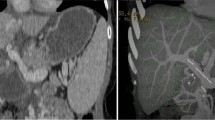Summary
The two main indications for liver grafting are primary malignancy and parenchymatous liver disease. In both cases orthotopic transplantation remains the preferred technique. Since graft rejection was considered no to be the main problem in clinical liver transplantation, recent improved survival rates were reported to be due to a more aggressive diagnostic management and consequent treatment of postoperative complications nonrelated to graft rejection. Because of the limited number of organs available for organ grafting sometimes technical modifications may become necessary. This was the case in a 40-year old male patient suffering from primary malignant hepatoma. The donor was a child, and during operation a great difference between organ size and length and diameter of the hepatic vessels became evident. Orthotopic transplantation was performed using an unusual method of caval vein anastomosis. Initially the patient did very well, but later on liver function deteriorated and the patient died on the eighth postoperative week because of hepatic artery thrombosis. The autopsy showed that all other vascular anastomosis were patent and no signs of portal hypertension were evident. The surgical technique used in this case is described in detail and some interesting aspects are discussed.
Zussamenfasung
Einc Indikation zur Lebertransplantation kann sich grundsätzlich bei neoplastischen und nichtneoplastischen Lebererkrankungen ergeben. Aus chirurgisch technischen Gründen wird die orthotope Transplantation bevorzugt.
Da die Anzahl geeigneter Transplantate naturgemäß sehr begrenzt ist, kann gelegentlich ein atypisches chirurgisches Vorgehen notwendig werden. Dies war bei einem 40jährigen Patienten mit primärem Hepatom der Fall, dem die Leber eines tödlich verunglüen Kindes transplantiert worden war. Wegen einer erheblichen Diskrepanz in Organgröße, Gefäßlänge und -durchmesser mußte hinsichtlich der Hohlvenenanastomose eine atypische Transplantationstechnik gewählt werden. Nach zunächst unkompliziertem Verlauf verstarb der Patient in der 8. postoperativen Woche an den Folgen einer arteriellen Thrombose. Bei der Sektion waren alle anderen Gefäßanastomosen intakt, Zeichen einer portalen Hypertension bestanden nicht. Die in diesem Fall angewandte chirurgische Technik und verschiedene bemerkenswerte Aspekte werden diskutiert.
Similar content being viewed by others
Literatur
Calne, R. Y.: The present status of liver transplantation. Transplant. Proc.IX, 209–216 (1977)
Calne, R. Y.: Liver transplantation. Transplant. Rev.2, 69–89 (1969)
Fortner, J. G., Kim, D. K., Shin, M. H., Yeh, S. D. J., Howland, W. S., Beattie, E. J.: Heterotopic (auxiliary) liver transplantation in man. Transplant. Proc.IX, 217–221 (1977)
Fortner, J. G., Yeh, S. D. J., Kim, D. K., Shin, M. H., Kinne, D. W.: The case for and technique of heterotopic liver grafting. Transplant. Proc.XI, 269–275 (1979)
MacDougall, B. R. D., Williams, R.: The indications for orthotopic liver transplantation. Transplant. Proc.IX, 247–251 (1979)
Roddy, H., Putnam, Ch. W., Fennel, R. H.: Pathology of liver transplantation. Transplant.22, 625–630 (1976)
Starzl, T. E., Porter, K. A., Putnam, C. W., Schroter, G. P., Halgrimson, C. G., Weil III, R., Hoelscher, M., Reid, H. A. S.: Orthotopic liver transplantation in ninety-three patients. Surg. Gynecol. Obstet.142, 487–505 (1976)
Starzl, T. E., Putnam, Ch. W., Hausbrough, J. F., Porter, K. A., Reid, H. A. S., Path, M. R. C.: Biliary complications after liver transplantation. With special reference to the biliary cast syndrome and techniques of secondary duct repair. Surgery81, 212–221 (1977)
Starzl, T. E., Koep, L. J., Schroter, G. P. J., Hood, J., Halgrimson, C. G., Porter, K. A., Weil III, R. The quality of life after liver transplantation. Transplant. ProcXI, 252–256 (1979)
Starzl, T. E., Koep, L. J., Halgrimson, C. G., Hood, J., Schroter, G. P. J., Porter, K. A., Weil III, R.: Liver transplantation — 1978. Transplant. Proc.XI, 240–246 (1979)
Author information
Authors and Affiliations
Rights and permissions
About this article
Cite this article
Rigler, B., Zalaudek, G., Hermann, W. et al. Klinische Erfahrung mit einer atypischen Hohlvenenanastomose bei einem Fall von orthotoper Lebertransplantation. Langenbecks Arch Chiv 354, 31–38 (1981). https://doi.org/10.1007/BF01834014
Received:
Issue Date:
DOI: https://doi.org/10.1007/BF01834014




